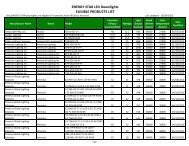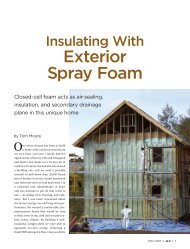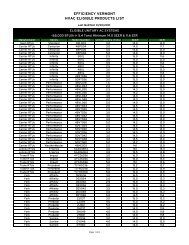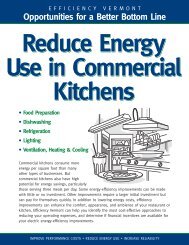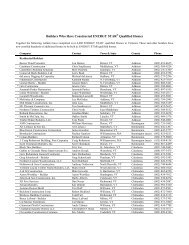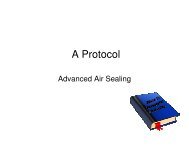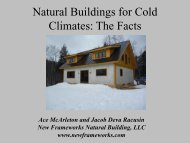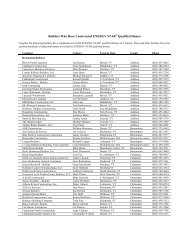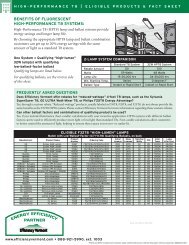Infrared Camera & Envelope Systems pdf - Efficiency Vermont
Infrared Camera & Envelope Systems pdf - Efficiency Vermont
Infrared Camera & Envelope Systems pdf - Efficiency Vermont
You also want an ePaper? Increase the reach of your titles
YUMPU automatically turns print PDFs into web optimized ePapers that Google loves.
under a pressure gradient. Image 6 shows the impact of<br />
warm air leaking out of this commercial building. This<br />
will typically go unnoticed until the fuel bill is paid.<br />
Image 6: All the framing and insulation is clearly visible in this<br />
commercial building. Normal pressure differences on the top<br />
floor result in air leaking past the envelope through various<br />
pathways.<br />
l EIFS construction<br />
The growing popularity of buildings using Exterior<br />
Insulation and Finish <strong>Systems</strong> (EIFS) has been accompanied<br />
by numerous cases of moisture-related structural damage.<br />
Although often attributed to leaking windows, water<br />
typically intrudes where sealing or flashing systems were<br />
inadequate or have begun to fail. Moisture is then trapped<br />
under the relatively impervious foam. In warm climates<br />
the decay of structural wooden elements, which can occur<br />
very rapidly, is a major problem. Mold growth also often<br />
accompanies the moisture resulting in health concerns.<br />
Thermography is an invaluable tool to locate moisture in<br />
EIFS systems. Inspections are best conducted in the early<br />
evening from the outside after a sunny day with little<br />
or no wind. It may also be possible to locate moisture<br />
from inside during cooling or heating conditions. The<br />
expanded foam insulation boards tend to become more<br />
absorbent to water over time.<br />
l Moisture intrusion or condensation<br />
As building designs and techniques produce tighter thermal<br />
envelopes, moisture (from leaks or condensation) has<br />
created more and more problems. The water can intrude<br />
through a small crack but it is then trapped between the<br />
relatively impermeable building materials. Good building<br />
techniques typically must deal with both air sealing and<br />
moisture retarders to keep moisture from accumulating<br />
inside the wall sections.<br />
Locating moisture with thermography is often simple<br />
because water has both a high thermal conductivity and<br />
a high heat capacitance. Determining the source of the<br />
moisture, however, can be difficult. Condensation, rather<br />
than leakage, is often the culprit so it is important to<br />
identify sources of air leakage that can transport moist air<br />
into the wall sections and the cold spots that can result in<br />
it condensing. The classic case is that of warm moist air<br />
leaking past the insulation in a metal building or mobile<br />
home; as it contacts the cold underside of the metal roof<br />
it condenses, and often freezes, causing the occupants<br />
the think, mistakenly, that the roof is leaking. Damage in<br />
building from condensation includes mold growth, brick<br />
spawling, roof membrane fastener corrosion and reduced<br />
insulation values.<br />
Image 7: EIFS construction is particularly susceptible to water<br />
intrusion resulting in both mold growth and wood rot problems.<br />
l HVAC performance<br />
HVAC systems can be plagued by design and installation<br />
problems resulting in excessive energy use and/or<br />
uncomfortable buildings. Thermography helps building<br />
specialists visualize the otherwise invisible impact of this<br />
poor performance as indicated by excessively hot or cold<br />
areas. Once these have been located, the root causes can<br />
be determined; these may include reversed or misdirected<br />
airflow or poorly placed supply ducts, leading to shortcircuiting<br />
of air directly to the return ducts.<br />
© 2008 The Snell Group / www.thesnellgroup.com



